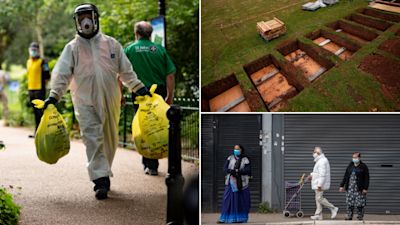Almost 120,000 could die from coronavirus in worst case scenario for winter peak, warns Academy of Medical sciences

Report by ITV News Trainee Fred Dimbleby
Video report by ITV News Health Correspondent Emily Morgan
Almost 120,000 people could die in a second coronavirus wave if the government does not begin "urgent preparation", a new report has found.
The report warns that any surge in Covid-19 cases, alongside the usual winter pressures faced by the NHS, would result in services becoming overwhelmed.
Common arthritis drug Dexamethasone could help prevent coronavirus deaths
UK was inundated by new coronavirus cases from abroad, genetic analysis reveals
It calls for a series of measures to prepare the NHS, including immediately reorganising social care services and increasing testing capacity.
The scientists behind the report have predicted there will be a huge backlog of patients needing NHS care this winter, while the possibility of a flu epidemic will add even more pressure.
The Academy of Medical Sciences (AMS) was asked by the Government's Chief Scientific Advisor Sir Patrick Vallance to assess the different risks the NHS faces this winter.
Scientists are predicting there will be an increase in Covid-19 cases, with evidence now suggesting the virus thrives in colder temperatures.
Professor Stephen Holgate, who led the report, said: "This is not a prediction, but it is a possibility."
"The modelling suggests that deaths could be higher with a new wave of Covid-19 this winter, but the risk of this happening could be reduced if we take action immediately."
He added: "With relatively low numbers of Covid-19 cases at the moment, this is a critical window of opportunity to help us prepare for the worst that winter can throw at us."
The report models a 'reasonable worst-case scenario' where the reproductive number of the virus, the R value, rises to 1.7 from September 2020.
In the March peak, the R value was 3 - meaning one infected person would pass it on to three others.
The report suggests this would lead to a peak in hospital admissions and deaths in January and February 2021.
The R value is presently estimated to be between 0.7 and 0.9. More than 44,000 people who had the virus have died.
Research suggests the virus is more likely to spread in winter because people spend more time indoors and it can survive longer in colder conditions with less sunlight.
A senior scientific advisor said on Friday that the virus thrives at a temperature of 4C.
A second wave in these conditions would be especially difficult to handle because of already increasing pressure and demand on the NHS in the winter months.
While the scientists model that the number of Covid-19 related deaths could be as high as 199,900 between September 2020 and June 2021, this does not take account of government actions to reduce the infection or the effect of new treatments for the virus such as the steroid Dexamethasone.
Both measures could lower death rates significantly.
The scientists also produced less severe epidemic scenarios with a lower R rate. If the R value was 1.1 from September to 2020 through to July 2021, then they estimate that the number of hospital deaths would be 1300.
If the R value for the same period was 1.5, the estimated figure is 74,800 indicating the significant difference that variations of the R value has on death rate.
The scientists could not model for deaths in care homes, one of the areas hit hardest by the first wave of the pandemic, so the estimated deaths totals come from hospitals alone.
The report, which was presented to the Scientific Advisory Group for Emergencies (SAGE) and will be shared with local authorities, has a number of recommendations to mitigate the impact of the virus in winter.
These include:
A public information campaign with advice focused on individuals and communities at high risk
Reorganisation of health and social care facilities and staff to maintain Covid-19 and Covid-19 free zones – and ensuring that there measures to minimise transmission such as adequate PPE supplies and testing in hospitals and care homes
Increasing capacity of the test, trace and isolate programme and the establishment of a population-wide surveillance system to manage and monitor an increase of infections
Extensive use of flu vaccination for those at most risk, as well as health and care workers, to limit the potential of widespread flu cases in the UK
The NHS was severely disrupted by the first wave of the pandemic leading to redeployment of staff and the authors of the report say, with extra pressures in winter, such reorganisation may not be possible again.
Professor Dame Anne Johnson, a member of the expert group for the project, said: "Faced with these potential challenges, and after an already tough year, it would be easy to feel hopeless and powerless."
"But this report shows that we can act now to change things for the better. We need to minimise coronavirus and flu transmission everywhere, and especially in hospitals and care homes."
"We need to get our health and social care, and the track, trace and isolate programme ready for winter. This can be done, but it must be done now."
A government spokesperson has said: "The modelling in this report represents a worst-case scenario based on no government action, and makes clear this isn’t a prediction."
"Thanks to the nation’s collective efforts, the virus is being brought under control. However we remain vigilant and the government will ensure the necessary resources are in place to avoid a second peak that would overwhelm our NHS."
"This includes extensive winter planning to protect the NHS and care sector, further expanding our large-scale testing capacity – contacting thousands through NHS Test and Trace, working intensively on new treatments, and delivering billions of items of PPE to protect our health and social care workers."
Coronavirus: Everything you need to know
Check the number of cases in your area with our interactive map
Listen and subscribe to our podcast